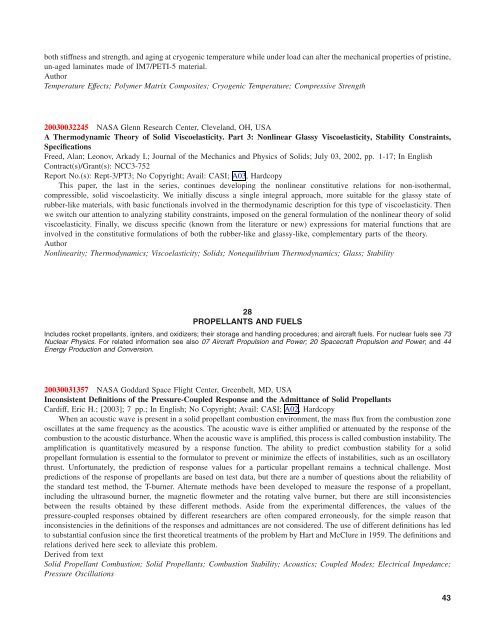Create successful ePaper yourself
Turn your PDF publications into a flip-book with our unique Google optimized e-Paper software.
oth stiffness and strength, and aging at cryogenic temperature while under load can alter the mechanical properties of pristine,<br />
un-aged laminates made of IM7/PETI-5 material.<br />
Author<br />
Temperature Effects; Polymer Matrix Composites; Cryogenic Temperature; Compressive Strength<br />
20030032245 NASA Glenn Research Center, Cleveland, OH, USA<br />
A Thermodynamic Theory of Solid Viscoelasticity. Part 3: Nonlinear Glassy Viscoelasticity, Stability Constraints,<br />
Specifications<br />
Freed, Alan; Leonov, Arkady I.; Journal of the Mechanics and Physics of Solids; July 03, 2002, pp. 1-17; In English<br />
Contract(s)/Grant(s): NCC3-752<br />
Report No.(s): Rept-3/PT3; No Copyright; Avail: CASI; A03, Hardcopy<br />
This paper, the last in the series, continues developing the nonlinear constitutive relations for non-isothermal,<br />
compressible, solid viscoelasticity. We initially discuss a single integral approach, more suitable for the glassy state of<br />
rubber-like materials, with basic functionals involved in the thermodynamic description for this type of viscoelasticity. Then<br />
we switch our attention to analyzing stability constraints, imposed on the general formulation of the nonlinear theory of solid<br />
viscoelasticity. Finally, we discuss specific (known from the literature or new) expressions for material functions that are<br />
involved in the constitutive formulations of both the rubber-like and glassy-like, complementary parts of the theory.<br />
Author<br />
Nonlinearity; Thermodynamics; Viscoelasticity; Solids; Nonequilibrium Thermodynamics; Glass; Stability<br />
28<br />
PROPELLANTS AND FUELS<br />
Includes rocket propellants, igniters, and oxidizers; their storage and handling procedures; and aircraft fuels. For nuclear fuels see 73<br />
Nuclear Physics. For related information see also 07 Aircraft Propulsion and Power; 20 Spacecraft Propulsion and Power; and 44<br />
Energy Production and Conversion.<br />
20030031357 NASA Goddard Space Flight Center, Greenbelt, MD, USA<br />
Inconsistent Definitions of the Pressure-Coupled Response and the Admittance of Solid Propellants<br />
Cardiff, Eric H.; [2003]; 7 pp.; In English; No Copyright; Avail: CASI; A02, Hardcopy<br />
When an acoustic wave is present in a solid propellant combustion environment, the mass flux from the combustion zone<br />
oscillates at the same frequency as the acoustics. The acoustic wave is either amplified or attenuated by the response of the<br />
combustion to the acoustic disturbance. When the acoustic wave is amplified, this process is called combustion instability. The<br />
amplification is quantitatively measured by a response function. The ability to predict combustion stability for a solid<br />
propellant formulation is essential to the formulator to prevent or minimize the effects of instabilities, such as an oscillatory<br />
thrust. Unfortunately, the prediction of response values for a particular propellant remains a technical challenge. Most<br />
predictions of the response of propellants are based on test data, but there are a number of questions about the reliability of<br />
the standard test method, the T-burner. Alternate methods have been developed to measure the response of a propellant,<br />
including the ultrasound burner, the magnetic flowmeter and the rotating valve burner, but there are still inconsistencies<br />
between the results obtained by these different methods. Aside from the experimental differences, the values of the<br />
pressure-coupled responses obtained by different researchers are often compared erroneously, for the simple reason that<br />
inconsistencies in the definitions of the responses and admittances are not considered. The use of different definitions has led<br />
to substantial confusion since the first theoretical treatments of the problem by Hart and McClure in 1959. The definitions and<br />
relations derived here seek to alleviate this problem.<br />
Derived from text<br />
Solid Propellant Combustion; Solid Propellants; Combustion Stability; Acoustics; Coupled Modes; Electrical Impedance;<br />
Pressure Oscillations<br />
43
















